Image courtesy of h5 architecture
Why Fiberglass?
Overview
back to topFiberglass is created by pulling strands of glass through a heated die, resulting in a material that is strong, resilient, and suited to all weather conditions. Essentially a carbon fiber product, it has been used for many purposes, including boats, satellites, bridges, and goalie masks, where it is subject to extreme temperatures and constant abuse.
Fiberglass can meet a wide variety fenestration needs, from design, to durability, to performance objectives. Learn why fiberglass is an optimal framing material by exploring its characteristics in the tabs below.

Energy Efficiency
back to topConductivity
Energy efficient frames have low conductivity that discourages the transfer of heat or cold into a building. Fiberglass has a much lower conductivity than metal options; simply placing a hand on a fiberglass frame compared to an aluminum frame in -20°C weather makes the difference very clear.
THERM Results
The warmth of the frame can be seen in the below models. Fiberglass is much less conducive to allowing cold temperatures to pass through the frame, thus helping to prevent condensation and loss of heat. To achieve maximum energy efficiency, pair with DUXTON’s High Performance Glass.
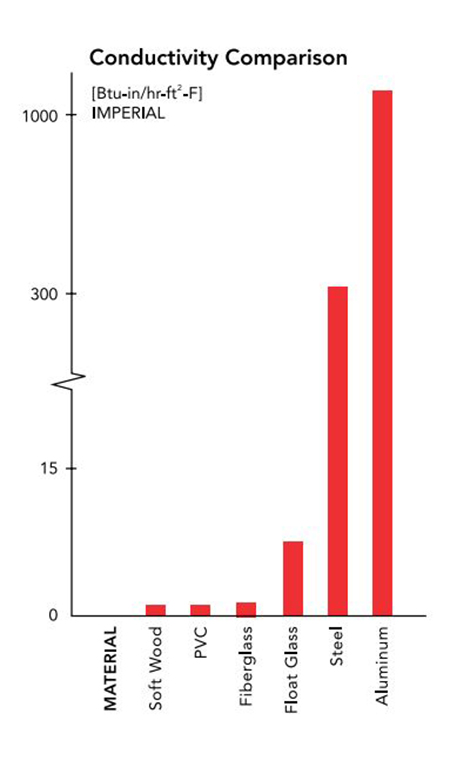

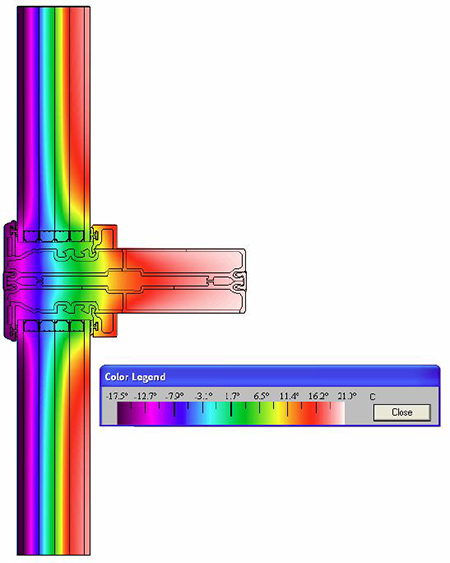
Better Seals
Subjected to temperature extremes, windows must remain stable, with minimal expansion and contraction to keep an excellent seal. Considering that the bulk of a window is glass, what better material to surround it with than glass? Hence “Glass on Glass Advantage”. Composed of about 60% glass, fiberglass, like plate glass, has a very low rate of expansion and contraction (see graph below). Fiberglass maintains an excellent seal with reduced movement relative to the plate glass.
Superior stability also results in greater longevity, fewer seal failures, and better paint adhesion.
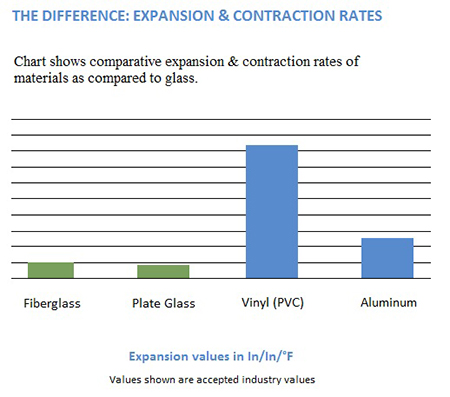
Design
back to topLarge Sizes with Slim Frames
Fiberglass offers significantly greater bend strength than PVC. Greater strength allows for slimmer frames, more glass area, and a better view. Even more valuable is that fewer frame divisions are required for large openings. Fiberglass can achieve stunning views with floor-to-ceiling glass that stretches across the length of the room. Bring the outside in!
Custom-Built Designs
DUXTON makes a point of responding to the creativity of architects and designers, even when the requested product is not “off the shelf”. We pride ourselves on building innovative, high-performance solutions to achieve the designer’s vision. We have become more specialized in contemporary windows and doors, and continue to develop our line to stay on top of current market demands.
Challenge DUXTON to provide your solution today!
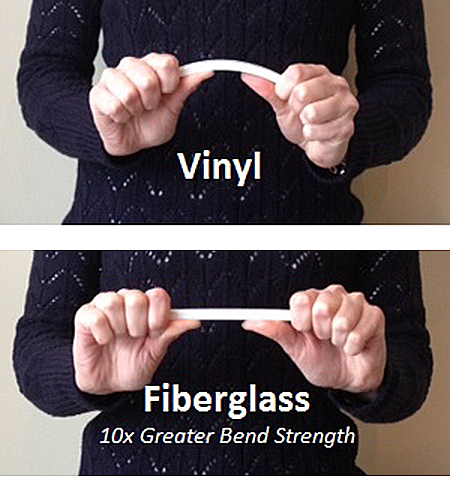
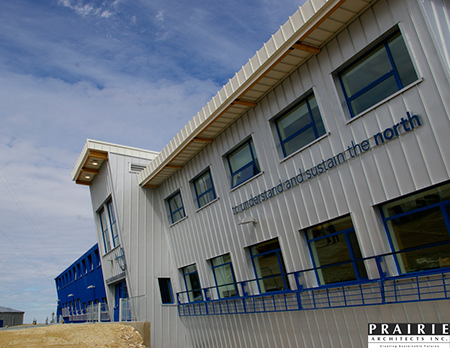
Churchill Northern Studies Centre –
Phototesy of Prairie Architects Inc.
Colour
Fiberglass also offers amazing colour flexibility. Unlike PVC which relies on light finishes, or exterior colour only, fiberglass offers endless colour options, inside AND out. The stability of the material allows you to select ANY colour, light or dark, standard or custom. Because fiberglass has a very similar application process to painting a vehicle, the finish is long-lasting and weather-resistant. See Colour Options
Wood Interiors
When the richness of wood is desired in combination with a low-maintenance exterior, fiberglass is an excellent choice in combination with a wood jamb extension. The wood interior can be stained to your colour of choice. Combined with a complementary frame colour, the window can enhance the living space in a way that is simply not achievable with an all-white interior.
Wood Jamb Extensions Available as a Paint Grade or Stain Grade
- Pacific Coast Hemlock (Standard Option)
- Oak
- Maple
- Mahogany
- Others by request
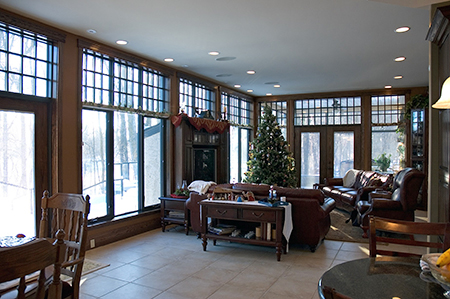
Custom home with Oak Stained Interior.
Durability
back to topFrame
Fiberglass is an extremely stable material predicted to last about 40% longer* than PVC windows. It also provides a low-maintenance finish that is applied similarly to the way that a vehicle is painted, creating a weather-resistant, long-lasting finish.
Fiberglass has been specified for a wide variety of commercial projects, including recreational centres, financial institutions, and multi-storey towers. Its durability has been proven by schools in the far north, where windows are subject to abuse and very extreme temperatures.
Protecting the Insulating Glass Unit
The stability of the material assists in protecting, and prolonging the life of insulating glass. Because the frame has minimal movement relative to the glass and the wall, there is less risk of seal failure or glass breakage.
Impact Resistance
Fiberglass is created with a combination of ultra-strong glass strands and glass matting. The glass matting that wraps around the glass strands assists in distributing any impact to the frame, preventing surface damage. In cases where the surface does become damaged, fiberglass can be repaired and re-painted.
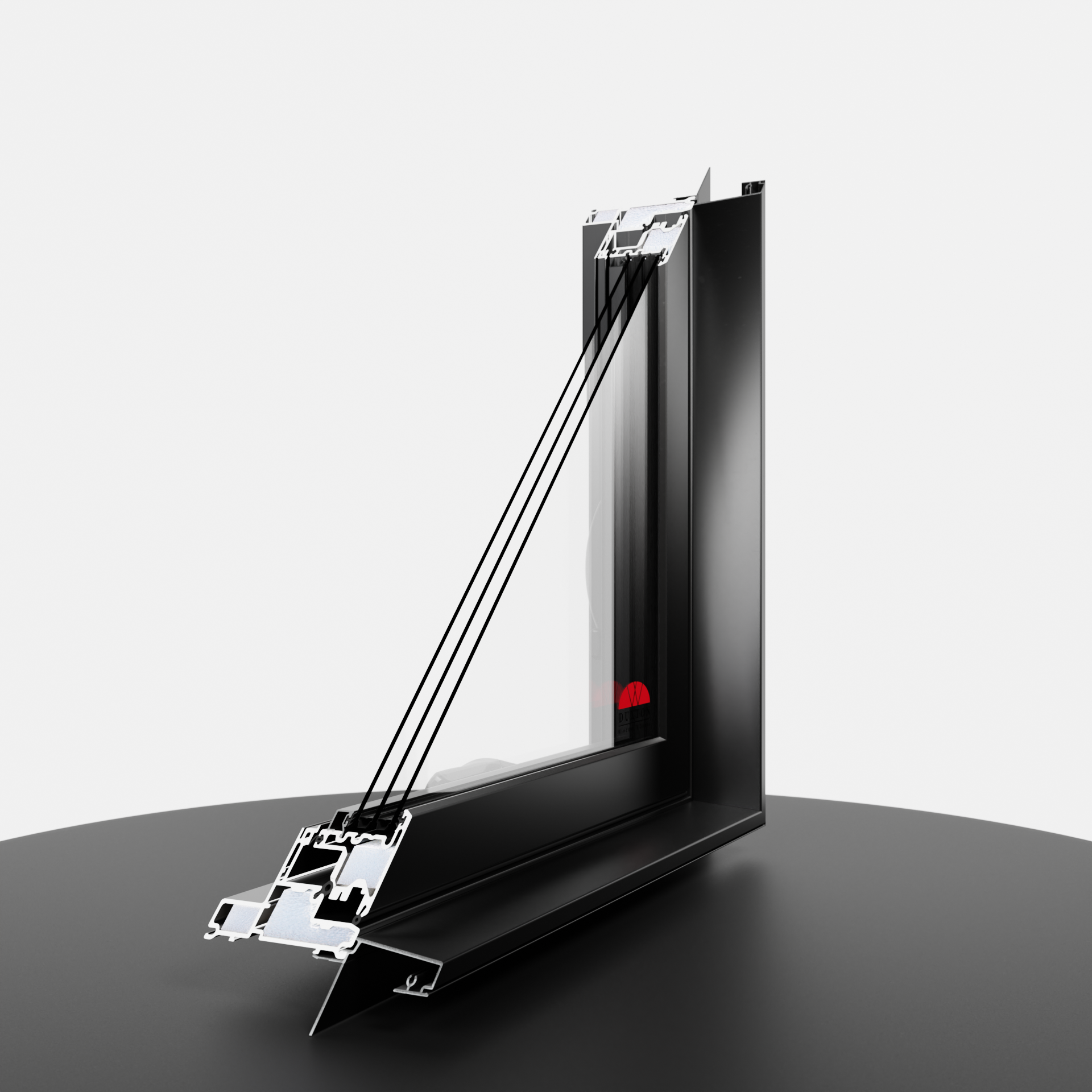
*Study from the University of British Columbia, “Life cycle assessment case study of North American residential windows” by James Salazar.
Comparative Cost
back to topVinyl & Metal-Clad Wood
The cost of windows and doors can vary broadly depending on the brand and the quality of the components. Based on the quality difference, fiberglass typically costs more than vinyl. A select number of vinyl brands actually have similar pricing to fiberglass. Compared to metal-clad wood, fiberglass is often fairly comparable in price, but again, varies by brand.
The key consideration lies in the value proposition. Fiberglass is often the material of choice for architects and engineers due to its greater design flexibility, excellent performance characteristics, and longer lifespan. Given that an investment in windows is significant, it is worthwhile to invest in a higher quality product to put off a second replacement for as long as possible.
Aluminum
In commercial settings, fiberglass can cost somewhat more than basic non-thermally broken aluminum, but typically cost less than thermally broken aluminum – while having better thermal performance.
Due to the low conductivity of fiberglass, it does not need thermal breaks, and hence, the system requires fewer components. In addition, aluminum can have costly site labour requirements, whereas most fiberglass systems can have significant labour downloaded to the factory.
Whereas fiberglass is typically seen as a product for punched openings, it is being increasingly used for small- to medium-sized curtain wall applications due to its superior thermal performance.
Environmental Impact
back to topManufacturing
At 60% glass content*, the basis of fiberglass is silica sand, one of the most abundant naturally occurring materials available on earth. Fiberglass also has a very low level of embodied energy and requires only about 20-25% of the energy required to convert bauxite into aluminum.
*Bruteforcecollaborative.com “Window Embodied Energy”

EchoHaven – Calgary, AB. One of CMHC’s Equilibrium™ demonstration projects. Photo courtesy of Canada Mortgage and Housing Corporation (CMHC).

Riverdale Net Zero Project – Habitat Studio, Edmonton, AB.
Longevity
Fiberglass also has a smaller impact on the environment due to its longevity. In a throwaway society, investing in durable products is becoming more and more vital. By choosing longer lasting, better quality products, we can keep more out of the landfills. DUXTON is an advocate of long-term sustainability, and believes in building for generations, not years.
Reduced Energy Consumption
In combination with DUXTON’s high-performance glass, fiberglass can assist in significantly reducing heating and cooling loads. See Glass Performance Values. The most significant savings are achieved by working closely with an energy expert, and tying the windows into a well-designed building envelope, with careful attention to the installation.
Achieving Rigorous Energy Standards
Due to its energy performance and the nature of the material, fiberglass is often selected for Net Zero, LEED, and PassivHaus projects.
